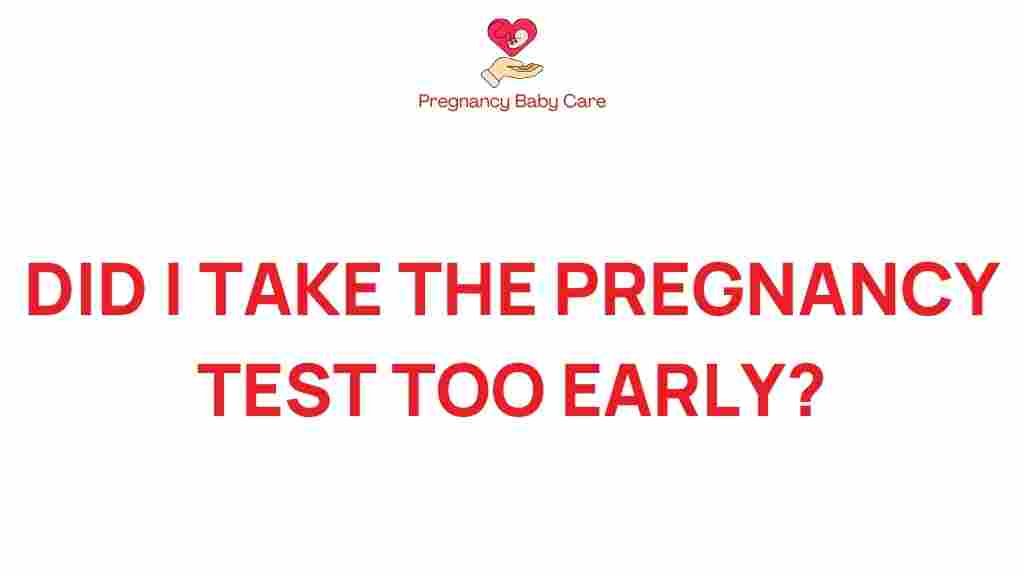Timing is Everything: Did I Take the Pregnancy Test Too Early?
When it comes to confirming a pregnancy, timing can be everything. Many women find themselves questioning whether they took their pregnancy test too early, especially when they experience early signs of pregnancy but receive a negative result. Understanding the intricacies of early testing, pregnancy symptoms, and the science behind hormone levels can help demystify the process and alleviate confusion. In this article, we will explore the pregnancy timeline, discuss common concerns related to false negatives, and provide a comprehensive guide to ensure accurate testing.
Understanding the Pregnancy Timeline
To grasp the concept of early testing, it’s important to understand the typical pregnancy timeline. An average menstrual cycle lasts about 28 days, but this can vary significantly from woman to woman. Ovulation typically occurs around day 14 of the cycle, and conception can happen within 24 hours of ovulation.
Here’s a brief breakdown of the pregnancy timeline:
- Day 1: The first day of your last menstrual period (LMP).
- Day 14: Ovulation occurs, and the egg is released.
- Days 15-16: Conception can occur if sperm is present.
- Days 20-24: Implantation of the fertilized egg in the uterus.
- Days 25-28: The body starts producing hCG (human chorionic gonadotropin), the hormone detected by pregnancy tests.
Typically, a pregnancy test can detect hCG levels about a week after a missed period, but many women test earlier, leading to questions about the accuracy of their results.
When to Take a Pregnancy Test
The best time to take a pregnancy test is after you’ve missed your period. However, if you suspect that you may be pregnant, you might be tempted to test earlier. Here are some considerations:
- Timing of Ovulation: If you have irregular cycles, pinpointing ovulation can be difficult. Testing too early may lead to a false negative.
- Hormone Levels: hCG levels double approximately every 48 hours in early pregnancy, meaning that testing too soon might miss lower levels of hCG.
- Test Sensitivity: Some tests are more sensitive than others and can detect lower levels of hCG.
Common Pregnancy Symptoms
Before taking a test, you might notice some early pregnancy symptoms. These can include:
- Missed period
- Nausea or morning sickness
- Breast tenderness or changes
- Increased urination
- Fatigue
- Food aversions or cravings
While these symptoms can indicate pregnancy, they can also be caused by other factors, such as hormonal changes or stress. Thus, it’s essential to confirm with a pregnancy test.
Understanding False Negatives
A false negative occurs when a pregnancy test indicates that you are not pregnant, even though you are. This can happen for several reasons:
- Testing too early: If you take a test before your body has produced enough hCG, you may receive a negative result.
- Improper testing: Not following the instructions correctly can lead to inaccurate results.
- Expired test: Using a test that has passed its expiration date can affect accuracy.
- Diluted urine: Testing with diluted urine (for example, after drinking a lot of fluids) can lower hCG concentration and lead to a false negative.
How to Increase Testing Accuracy
To enhance the accuracy of your pregnancy test, follow these guidelines:
- Wait until after your missed period: This is the most reliable time to test.
- Use first-morning urine: This urine is typically more concentrated and contains higher levels of hCG.
- Follow instructions carefully: Read and follow the test instructions to avoid user error.
- Consider the test sensitivity: Choose a test that is capable of detecting low levels of hCG.
Step-by-Step Guide to Taking a Pregnancy Test
Here’s a straightforward process to follow when taking a pregnancy test:
- Gather your materials: You will need a pregnancy test kit and a clock or timer.
- Choose the right time: Preferably first thing in the morning, after your missed period.
- Collect your sample: Use the test stick according to the instructions – either by holding it in your urine stream or dipping it in a collected urine sample.
- Wait for the results: Follow the timing guidelines provided in the test kit for accurate results.
- Read the results: Interpret the results as indicated in the kit. Be sure to check the control line to ensure the test is valid.
Troubleshooting Tips
If you receive unexpected results, here are some troubleshooting tips:
- Retest in a few days: If you suspect you tested too early, wait a few days and try again.
- Consult a healthcare provider: If you continue to receive negative results but still suspect pregnancy, or if you have persistent symptoms, seek medical advice.
- Consider a blood test: Blood tests can detect pregnancy earlier than home tests and are more accurate.
Conclusion
In conclusion, timing is indeed crucial when it comes to taking a pregnancy test. Understanding your ovulation and conception timeline can significantly impact the accuracy of your results. If you find yourself questioning whether you took the test too early, consider the factors we discussed, including hormone levels and the potential for false negatives. Always remember that if uncertainty persists, consulting with a healthcare provider can provide clarity and reassurance.
For more information on pregnancy testing and related topics, check out this helpful resource. Additionally, you can explore our other articles on early pregnancy symptoms to stay informed about your health.
This article is in the category Pregnancy and created by PregnancyBabyCare Team
